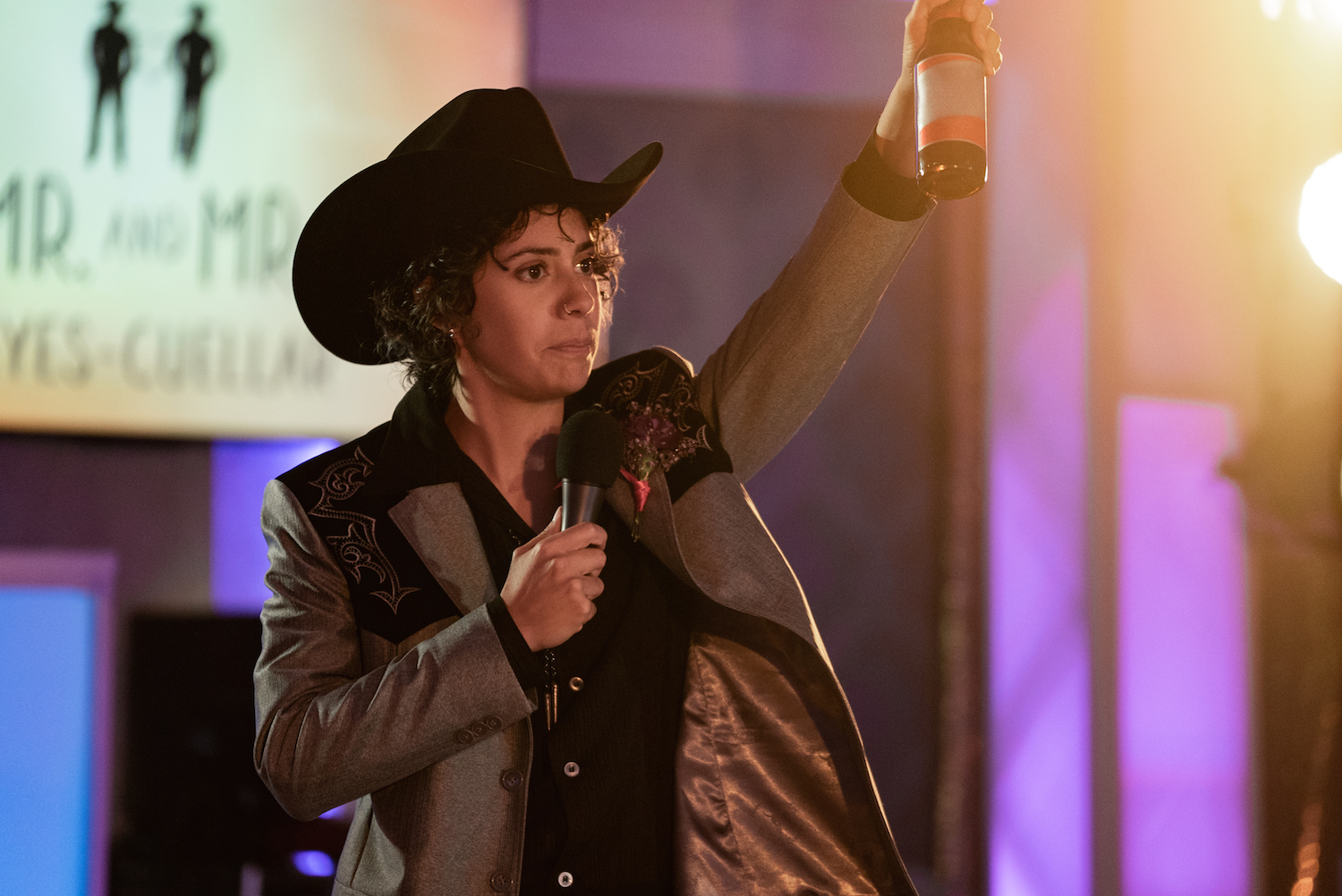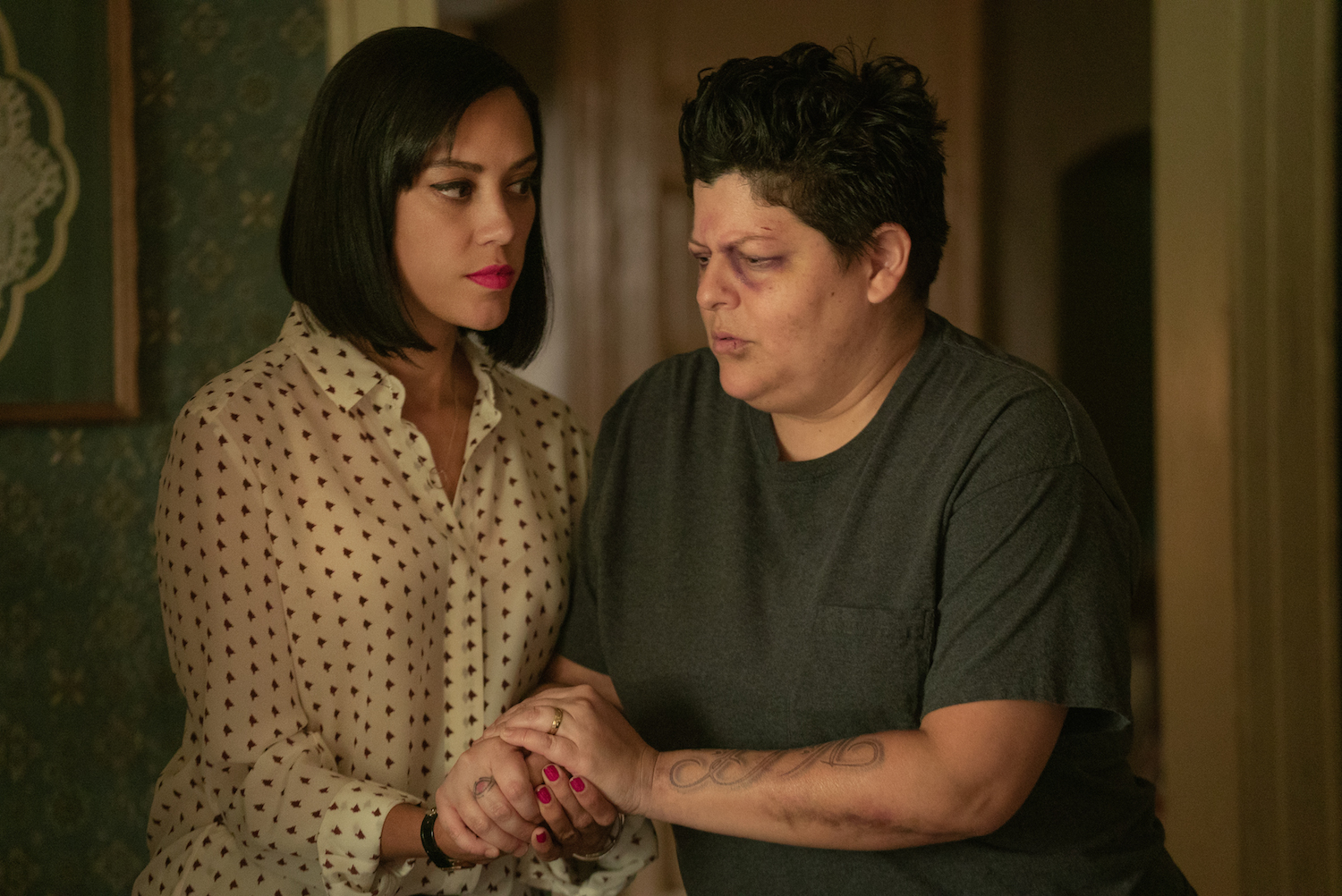There are many things Tanya Saracho is eager for audiences to see in the upcoming second season of her show, Vida. But one towers above them all: she can’t wait for viewers of the half-hour Starz drama to fall in love with Nico (Roberta Colindrez), a character she admits is basically her own dream girl, designed in the writers’ room. Befitting such a lofty label, she also came up with an introductory moment that’s bound to turn heads. In true Vida fashion, we first meet Nico at a gay vaquero-themed wedding where she’s the best man. For months, Saracho had fantasized about the precise moment Nico meets Emma (Mishel Prada) and greets her with a tip of her cowboy hat. Just talking about that moment made her giddy — about the fact that she’d somehow gotten Colindrez to join the ever-growing Vida family; about how she’d given her a “hat reading” so as to nail the moment; and also about how only in Vida would a meet-cute happen at a same-sex wedding hosted by a drag queen.
Nico’s butch swagger isn’t the only addition to the world of Vida. While audiences will still very much see Emma, her sister Lyn (Melissa Barrera), and their late mother’s wife Eddy (Ser Anzoategui) dealing with the fallout from their newfound business partners dynamics, Saracho is also introducing Raúl Castillo’s tatted up Baco, whom she described as both a hypermasculine “ex-cholo” as well as a super clean-cut European-looking Mexican politician. But don’t worry, with scenes focused on female orgasms (including safe sex when sharing vibrators) the show is not in any danger of being any less female-focused nor queer-centric. But with an extended episode order, Saracho was able to further broaden the world of Eastside Los Angeles that she begun sketching last season.
Depicting such a specific community facing issues of gentefication was always going to be a challenge. And as she takes stock about what worked in season one of a show that centered Latinas in front and behind the camera, Saracho is candid about the obstacles she’s faced and the criticism she weathered once the show premiered. “People outside the community were kinder,” she admits. “But Latinx were more passionate about everything. They had an opinion about everything — because they had skin in the game! Especially Latinx queers.” And so, while plenty of viewers reached out to the creative team to laud them for finally placing complex butch lesbians within a Mexican-American community and celebrating nonbinary actor Anzoategui’s portrayal of Eddy, there were just as many who nitpicked the show for everything from the girls’ use of Spanglish to Emma’s unorthodox taco-eating habits (which Saracho confirms will be dealt with in season two).

Part of the more vocal criticisms of the show came from the very community being portrayed: the show’s shoots in Boyle Heights were met with protests, making the issues of gentrification at the heart of Saracho’s storytelling feel all the more pressing. When asked how she dealt with that Saracho confesses she didn’t really. “At the core of it is the fear of being displaced. And there’s nothing I can say about that. It’s real, it’s really happening. So there’s no defense of it. Like, there’s no defending me. Yes, I’m not from Boyle Heights — that I can’t change. So I cried a lot. Because I was like, I’m doing it with all the due respect that it deserves. And so many of my writers are from the area — Boyle Heights, East LA, Highland Park, but that didn’t matter. The fear of displacement because of what they’re living is real. So there’s nothing I can say. Yes, it did hurt to be called ‘Whitetina,’ ‘coconut,’ ‘vendida’ (sellout).”
The fact that Saracho picked up the habit of obsessively reading tweets, reviews, and reactions from when she worked with Andrew Haigh on Looking likely makes facing those conversations that much harder. She’s not one to merely tune it out or deny the fact that she’s a gentefier, coming in with her Hollywood production trucks into an area that’s already facing very real challenges because of its changing demographics. “It’s happening, and there’s no denying it, and I don’t want to push it away. It’s the show in a way. I am the sisters, and I get it. So it’s complicated. I don’t have an answer. And I don’t disagree with them.”
As she talks about her upcoming project Brujas, you can hear the playwright-turned-showrunner making conscious decisions about continuing to make sure such community concerns are part of the development process. Just recently she got to assemble a team of all Afro-Latinx writers to flesh out what she has in store for the Chicago-set show’s pilot. In their conversations, they were clear that they want to tackle colorism in the Latinx community as well as issues of gender and sexuality that will expand what Saracho is doing in Vida. And also, of course, take the chance to center African and indigenous traditions within a genre show.

“I’m excited to explore all this because magic has been very Eurocentric. According to Hollywood, you know we’ve had Practical Magic, The Craft, Charmed … it’s all like pagan Eurocentric-based stuff. We’ve never had the Yoruba and indigenous traditions ever represented except for like, Santería which has been either been funny (‘Oh look he’s killing a chicken!’) or evil (like Voodoo stuff). But all of these traditions — Yoruba, Santería, Ifá, Juru, and even curanderismo — have never been given their proper place.”
As with Vida, it all comes down to celebrating those cultures and characters that have so often been relegated to the margins and putting them right at the center of a new generation of stories. The kind which can include both cowboys and witches.
Vida season 2 premieres May 26 and will air weekly on Starz at 8 p.m. All episodes will be available on the Starz app beginning May 23.







